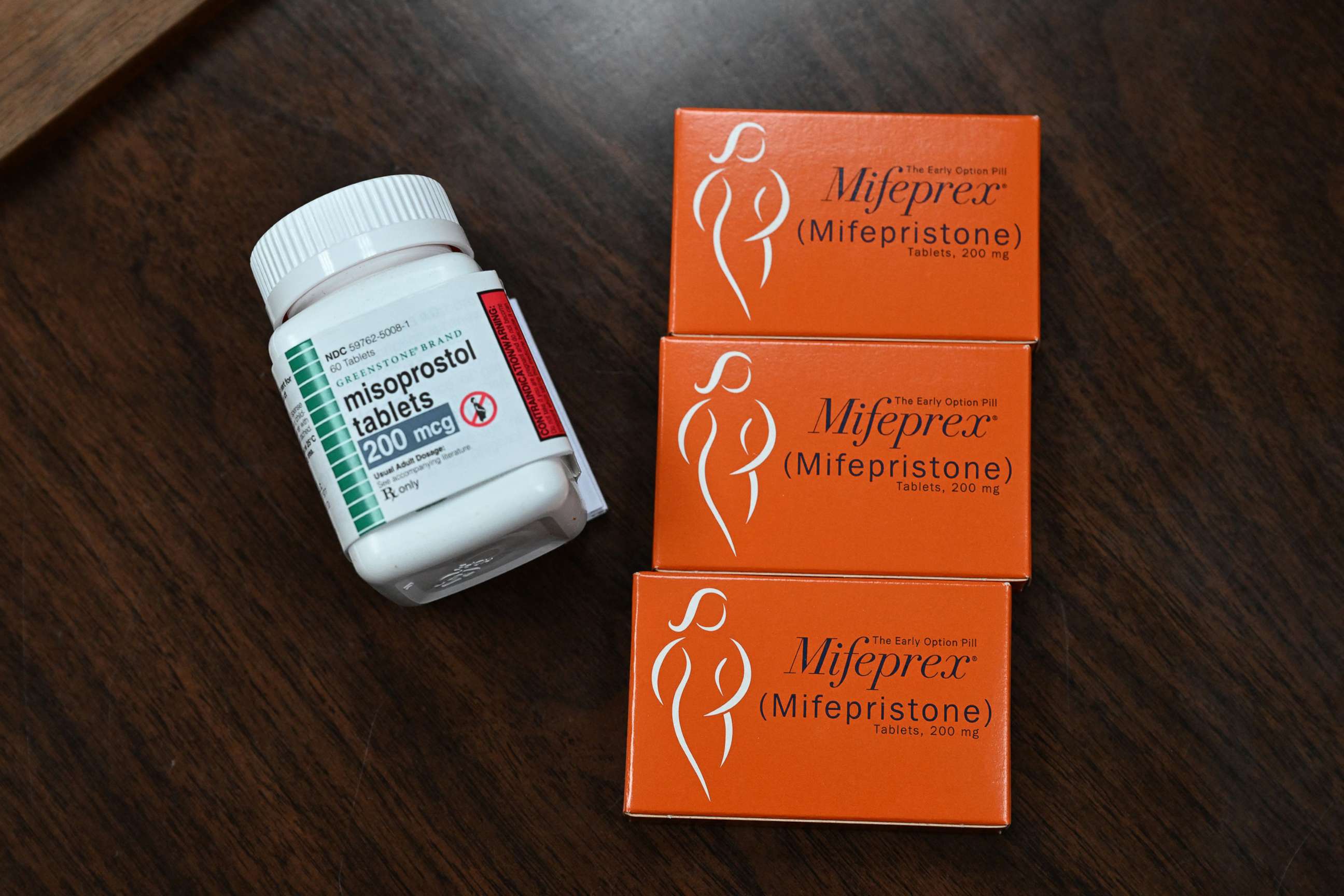This is how mifepristone and misoprostol induce abortions
Just under 1 million people utilized abortion services in the U.S. in 2020, according to recent data from the Guttmacher Institute. Another report from Guttmacher in 2016 showed that 90% of abortion patients in the U.S. obtained their procedure in the first trimester.
Medication abortion is approved by the Food and Drug Administration for up to 10 weeks into pregnancy, but there is good literature that has shown it is an effective method of abortion up to 11 weeks. This means the majority of people seeking abortion services are able to get medication abortions, Dr. Deborah Bartz, a gynecologist at Brigham and Women's in Boston, told ABC News in an interview.
The abortion pill is the most common form of abortion in first trimester pregnancies, with recent data showing that 54% of those eligible now choose to undergo medication abortion over a procedure, Bartz said.
As access to abortion continues to be restricted in many states, more may choose to self-manage their abortions for several reasons, such as not being able to afford to travel for care, according to Dr. Meera Shah, chief medical officer of Planned Parenthood Hudson Peconic.
Self-managed abortions were often risky pre-Roe, but abortion medication has offered a safe method for self-induced abortions.
Many patients in other countries have taken the abortion pill past 11 weeks, and there are several ongoing studies underway for usage of the pill beyond 11 weeks, Bartz said.
"You can take medications and induce pregnancy expulsion, essentially, at any gestation. It's just as of right now, our literature indicates that 11 weeks is the upper limit on when we should be recommending that to most patients," Bartz said.
How does medication abortion work?
The most robust and effective way to get a medication abortion is by taking two pills: mifepristone and misoprostol, Bartz said.

Mifepristone, which is taken first, blocks the hormone progesterone. Progesterone is needed for the pregnancy to grow inside the uterus. When mifepristone is taken, it begins the process of emptying the uterus.
Mifepristone can be taken at home or in a healthcare provider's office.
The second medication, misoprostol is taken within 24 to 48 hours of the first medication. This causes uterine cramping and cervical softening and expels the pregnancy from the body, Bartz said.
Misoprostol causes cramping and bleeding, similar to a heavy period or miscarriage, to empty the uterus, according to Dr. Meera Shah, Chief Medical Officer of Planned Parenthood Hudson Peconic.
"By taking the two medications together, what an individual is doing is essentially inducing a miscarriage. There are other means of doing medication abortion, and many people in the United States and throughout the world use misoprostol only. That is also a very good regimen," Bartz said.
The Mifepristone-Misoprostal regimen is about 95% effective if taken within the first 11 weeks of pregnancy, while the misoprostal alone is about 85% effective, Bartz said.
Symptoms and risks
The process itself takes a couple of hours. The further along patients are in the pregnancy, the more complex their symptoms may be and the longer their symptoms might last, according to Bartz.
Patients typically experience bleeding and cramping, which can be more severe the further along they are in pregnancy. This typically results within one to five hours, Bartz said.
"It's probably a little bit more intense than like the first day of a person's period. So, a little bit heavier bleeding than a period, a little bit more cramps than a period. But, there are many patients who experience symptoms that are not much more than their period," Bartz said.
It is recommended that patients not be alone when they take the pills in case they experience more pain than expected or have heavy bleeding. Patients are usually advised to take pain medication, like ibuprofen, and maybe an anti-nausea medication ahead of time, before the cramps start, Bartz said.
Patients also experience flu-like symptoms including fevers, chills, nausea, vomiting and diarrhea, all of which is normal with medication abortions, Bartz said.
When a person becomes pregnant, they are automatically in a higher risk category than someone who is not pregnant. So, getting an abortion of any kind puts a patient at less risk than if they continue a pregnancy, according to Bartz.
"The risk of maternal mortality associated with full term pregnancy and delivery is about 14 times higher than the risk of interrupting a pregnancy with a either medical or surgical abortion," Bartz said.
Roughly 5% of patients experience incomplete abortions, meaning the pregnancy does not pass in its entirety. In these rare cases, the medication might not work the first time around, and they either have a continuing pregnancy or they have clinically significant pregnancy tissue that does not pass all the way, Bartz said.
"So they actually potentially would need either a second dose of the medications or to undergo the surgical the uterine aspiration procedure to bring those that pregnancy tissue out after they've taken that medication if it hasn't worked. But 95% of patients, have the medication work just fine the first time," Bartz said.
Rarely, some patients who experience severe bleeding may need to call their physician's office or be seen in an emergency room for a blood transfusion. Less than 1% of patience experience bleeding significant enough that they would need a blood transfusion, Bartz said.
"If a patient is bleeding so heavily that she's soaking pads a pad, an hour for a couple of hours, then we would want to see her," Bartz said.
Another rare risk is the risk of an infection. As the cervix opens up a bit, there is a low risk that an infection could travel to the uterus, but doctors do not even prescribe antibiotics to prevent risk of infection because there is more risk from taking the antibiotic than there is of getting an infection, Bartz said.
Patients can experience mild or moderate bleeding and cramping on and off for up to a month after taking the abortion pill. Most get their next period one to two months after the abortion, according to Dr. Meera Shah, Chief Medical Officer of Planned Parenthood Hudson Peconic.
Having an abortion does not decrease your chance of having a healthy pregnancy later on, or affect your future overall health unless a rare, serious complication occurs or is left untreated, according to Shah.




